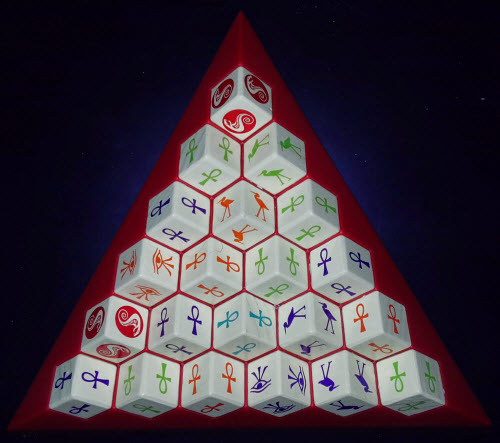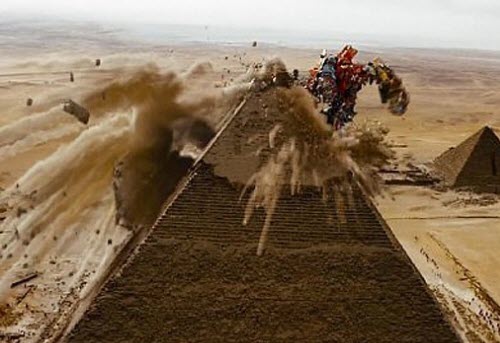For reasons that almost seem to escape us at times, humans are captivated by pyramids. From Mesopotamia to East Asia, to the Americas, and back to the iconic Egyptian landscape, almost every major ancient civilization sought to inspire and immortalize their people by building these triangular buildings of earth and stone. Part mysticism, part engineering marvel, pyramids have elicited thoughts on them for millennia.
Over time we’ve matured as a people and…well, we’re still building them on occasion. Except we’re mostly using glass and steel.
What? People like pyramids. We just went over this…
The Premise
Just like the pyramids of the ancient world, Pyramix entices everyone to uncover what lies within its walls, and it’s up to the players to figure out what those secrets may yield. In this abstract game of pyramid deconstruction, everyone takes turns removing cubes to build up their cache of points and uncover what’s hidden underneath. Just watch out for snakes!
The Rules
Pyramix is a delightfully short decision-making game for 2-4 players, and setup is practically nonexistent. The game consists of a three-sided cube tray and 56 wooden cubes. These cubes are randomly stacked atop the tray to create a pyramid. Once completed, the game begins. In Pyramix, the person with the most triangular nose starts.
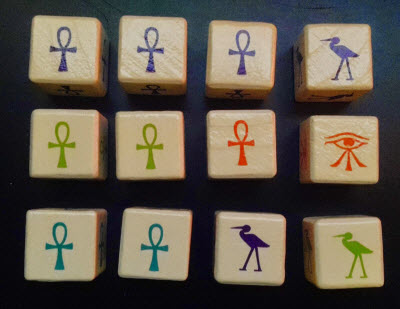
This player nets 17 points.
Player turns are incredibly simple. It consists simply of them removing one cube from the pyramid and adding it to their pool. Most cubes in Pyramix come in one of four colors and have one of three possible symbols: Ankhs, Cranes, and Eyes. At the end of the game, each Ankh a player has is worth one point, each Crane is worth two, and each Eye is worth three.
However, there are also four Cobra cubes dispersed randomly to thwart players. Like all other cubes, Cobras can be removed by players, but they aren’t worth any points.
Removing a cube from the pyramid follows three simple rules:
- At least two sides of the cube must be visible.
- It cannot expose the base of the pyramid tray.
- It cannot be touching a Cobra cube.
So long as it fits these criteria, a player may remove it. For example, the cube could be near the top of the pyramid, or it could be one closer to the bottom, causing cubes to shift position. Then the next player selects a cube, and so on.
Players continue taking turns removing cubes until only those covering the pyramid basin remain. This triggers the endgame of Pyramix. Rather than remove these cubes normally, the final cubes are awarded to players based on the cubes they’ve collected throughout the game.
First, any Cobras in the base and any cubes adjacent to them are removed from the game. Then, each player adds up the number of Ankhs they have of each color. For each of the four colors, the player with the most Ankhs is awarded any dice still on the tray of the same color. If there is a tie, no one receives them.
After the cubes of all four colors are doled, out, players count up the point value of all the cubes they possess. The winner is the player with the highest point total, having most tactfully navigated the pyramid. Everyone else can stick around and help build a new one.
But make it 1,000 times bigger this time, k?
Building Some Fun
Most of us are first exposed to games as children. They can be a wonderful use of time, whether it’s because of the worlds they take place in or the premises they offer. Some games even teach young players about making basic decisions as opposed to being purely luck-driven exercises. For most young people, however, these decision-making aspects aren’t what gets them excited to play time and again. Rather, most are drawn in to the experience the game offers. From munching marbles to climbing ladders, they are entertained by what they – or the game – is doing. And one of the most common ways to accomplish that is to have moving pieces to interact with.
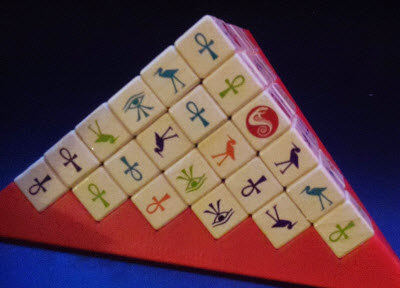 Spinners, dice poppers, moving parts – these components have unique physical qualities and have been used to entice and amuse young gamers for decades. Games like Mouse Trap, Trouble, and Battleship have been entertaining gamers for 50 years, and they continue to do so in part because they let you interact with the game as it’s happening. You can actually see and process what’s transpiring.
Spinners, dice poppers, moving parts – these components have unique physical qualities and have been used to entice and amuse young gamers for decades. Games like Mouse Trap, Trouble, and Battleship have been entertaining gamers for 50 years, and they continue to do so in part because they let you interact with the game as it’s happening. You can actually see and process what’s transpiring.
As you age out of these children’s games and discover ones with far more variety to offer, those early games remain appreciated to some degree due long after you’ve realized how flawed most them really are due to the fact you got to physically engage with them.
Pyramix continues this appreciation. One of this game’s most appealing aspects is that the landscape of the pyramid physically shifts and changes on each player’s turn. Taking a cube from lower in the pyramid causes the rest of the column to slide down, evoking that sense of gaming adventuring that’s generally relegated to cards, meeples, and / or little wooden resources. Pyramix taps into that long-held sensation and offers up a refreshing game that can be appreciated by players of almost any age.
Coffee Table Games
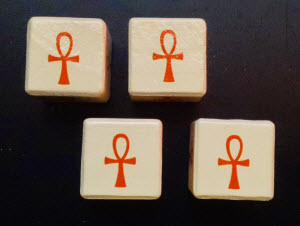
Who needs eyes anyway?
Having the pyramid regularly change also affects a player’s light strategic options. Pyramix is certainly a family-friendly game with a simple set of rules, but it is not devoid of choice.
Sometimes it is more advantageous, for instance, to take an Ankh over a Crane or an Eye to help your chances of securing the remaining cubes at the end of the game. Other times you may take a cube simply to cause a Cobra to move and block another player from their own sought-after treasure. There are enough simple decisions to make this 15 minute game easily worth the 15 seconds it takes to set up.
Truly, Pyramix is the ideal sort of Coffee Table Game. It moves along quickly and keeps players interested without requiring a heavy focus on what’s going on. It’s certainly beneficial to be mindful of what cubes other players have removed to help your chances, but Pyramix doesn’t require your undivided attention. For Socializers, this shapes up to be their kind of game.

Wrong Cobra. Though probably just as entertaining…
That said, Pyramix will not entice Architects, Tacticians, or Daredevils. Each turn consists of solely removing one cube, which doesn’t offer a lot of depth or room for diverse strategy. You can loosely plan ahead for your next cube or two, but the more players there are, the less likely it’ll be still on the pyramid, let alone in the same spot.
Strikers will have a hard time with this one too, as the game isn’t robust enough for them to gain any sense of accomplishment beyond maneuvering a Cobra to briefly disrupt another player. Pyramix just isn’t designed around being incredibly cutthroat.
Terrific Tetrahedrons
There’s also the fact that playing with three-dimensional pyramids is inherently fun for most people on an intrinsic level. Some like them for the geometric shapes. Others like them because they’re a iconic symbol of sturdy engineering. Still others enjoy their symbolic representation of human ingenuity and progress. Whatever the case may be, Pyramix evokes that notion, reinforced via its Egyptian hieroglyphics and triangularly-folded rules insert.
We’re just glad the box itself isn’t also pyramid shaped. Lines had to be drawn somewhere after all. (Granted, the box also tends to be oversized for its contents, but that’s hardly a major issue.)
Still, even with all of the pro-pyramid obeisance, don’t expect Immersionists to get much out of Pyramix. As with most abstract games, there isn’t a lot of flavor detail.
Indeed, Pyramix is all about taking a pyramid apart and digging down to its foundations. Initially it may seem like a triangular version of Jenga due to stacking up wood blocks and then systematically dismantling them, but Pyramix is more stable in a number of ways.
For one, it appeals to a wider play audience since this is not a dexterity game; no one will lose from having unsteady hands or bumping the table. For another, its playthroughs are elegant and simple but substantive enough that it leaves you wanting to play again. Pyramix seems to hit that nice spot of short and sweet, giving it great replay value. For really short non-card games, it’s a quality not seen with great frequency.
Just don’t expect it to be the centerpiece of your evening’s activities.
The Takeaway
As quick and light games go, Pyramix certainly stacks up. Pyramix is easy to set up, simple to learn, and it’s over in two shakes of a cobra’s tail. The game offers up some mild strategy, letting players make basic worthwhile decisions about which cubes to go for, but it never stays into complex territory. It also wisely ends before things ever start feeling repetitive. Indeed, this brief little game has a bit more under the surface than first appears, making it an ideal sort of game where time is an issue or if people are looking for something unencumbered to focus on while still being social. And all without getting sand in your shoes.
Pyramix is a product of Gamewright Games.
Cardboard Republic Snapshot Scoring (Based on scale of 5):
Artwork: 3
Rules Clarity: 5
Replay Value: 4.5
Physical Quality: 4
Overall Score: 4.5
Photo Credits: Cobra Commander by Hasbro; Transformers by Paramount Pictures.

